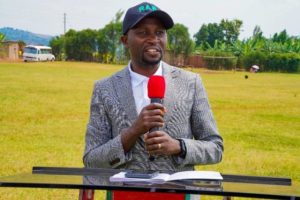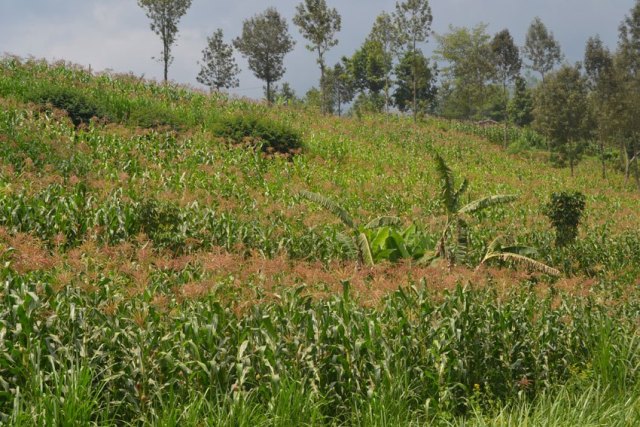Rwanda:Soil Conservation agriculture Programs have increased farmers’ productivity
Written by: Ngaboyabahizi Protais
People who participated in the soil conservation agriculture program in Burera District, Kagago sector, say that when they started farming without disturbing the soil, their harvests were increased many times over after learning the conservation agriculture, which also made their fields less prone to erosion,
This has also meant that their fields are no longer affected by erosion.
These farmers say that they suffered from a lot of energy in the long run but get low yields when they consume a lot, they are not satisfied with the food and they are always hungry in their families .
Conservation agriculture is a program that teaches farmers how to keep the soil from being disturbed by tilling the fields so that erosion does not continue.
This program also includes the rotation and mixing of crops in the fields in such a way as to prevent the soil from turning, farmers appreciate and solve their economic problems once they are satisfied and open the markets.
Nyangezi Berchimas is a farmer from Kagogo sector.He said: “From now on, where I cultivated all the fields I frequented, I harvested 60 kilos of maize, where I tended the land, I harvested 130 kilos, but where I planted without maintenance, I took out 45 kilos in a chaotic way, now I grow reeds and being I collect food and sell it in the market is the best way I use to bless children in schools and you understand it too”.
Yvette says that this method increased the yield for her, that what she harvested, she ate it and didn’t harvest the seeds, but because she does this kind of farming that preserves the soil, she got improved overall.
She said, “Where I was harvesting four sacks of beans, now I have to harvest seven and a half sacks, and the fertilizer I use is much less than what I used to spread in the field, but when I dig a hole and put some fertilizer in it, I know the plant will not die in vain.” I use half of what I used to, and the fruit has gone down and the yield has gone up”.
Kagogo farmers talk about groups of farmers who conserve the land and are trained by the Peace and Development Network, PDN, its director Harerimana Eustache says that it is time for the farmer to take care of the land and that this method has been in use for a long time and has proven itself.
He said: “When you look at the time when the land was cultivated, you see that it has lost its originality, which is what has reduced the yield. We help farmers maintain it so they produce the right amount and don’t get damaged”.
John Twiringiyumukiza, Tear fund and Canadian Food grains Bank’s Technical Advisor in West and Central Africa, also points out that it is good for the farmer to reform their farming practices and preserve the land, and he also points out that they will continue to play a role in supporting and reaching out to farmers
He said, “We hope that in five years we will have more than 60,000 farmers practicing soil-conserving agriculture, which will help them increase production and protect the environment, as it prevents erosion”. How is this breeding made to be productive?
When a farmer wants to prepare his field, he does not harvest the field or even the whole field.The advantage of not dividing the earth is that when it rains, it does not wash away the earth but seeps into it, so you will plant it like corn and dig a hole so that there is 75 centimeters between the holes. After that he puts the fertilizer full of water bottle, he puts the fertilizer full of water cover then soil and he gets to plant the seeds, after that the ball protects the plant, those things are important because as we said above it makes the floor they always have in trouble.
The farmer must be careful with the fertilizer he finds because sometimes it does not reach the plant. The grass that is sprayed in the field helps the field not to be washed away by erosion but to store water in the soil which nourishes the plant until it is harvested.
What does the Ministry of Agriculture of Rwanda say about this program?
The Ministry of Agriculture in Rwanda tells Rwandans to believe in the new agriculture which requires farming, saying it is reliable and can produce good results, even though it is new to Rwanda. Dr. Ildefonse Musafiri, Minister of MINAGRI, thinks that agriculture like this should be taught to Rwandans and said: “It is agriculture that creates the environment, you don’t plow the land and plant it and dig a place to put the plant and cover it, and this has three advantages, the first is erosion, because when it comes, the soil does not move. When you plant, it goes away easily. When it rains less, the water stays inside. The third is that it has been found that when you grow white rice you get more than three times more than conventional farming”.

Dr. Ildefonse Musafiri, Minister of MINAGRI(Picture rwandayacu.com).
Research has shown that this type of agriculture, preserving the land where it is produced, is productive and has been tested for two years in Rwanda; so far, some of the model agricultural extension workers have only been doing it for the two years that produce visible results. The Ministry of Agriculture and Livestock in Rwanda encourages farmers to participate because in Rwanda the population is increasing and the area is not increasing.
233 total views, 2 views today

